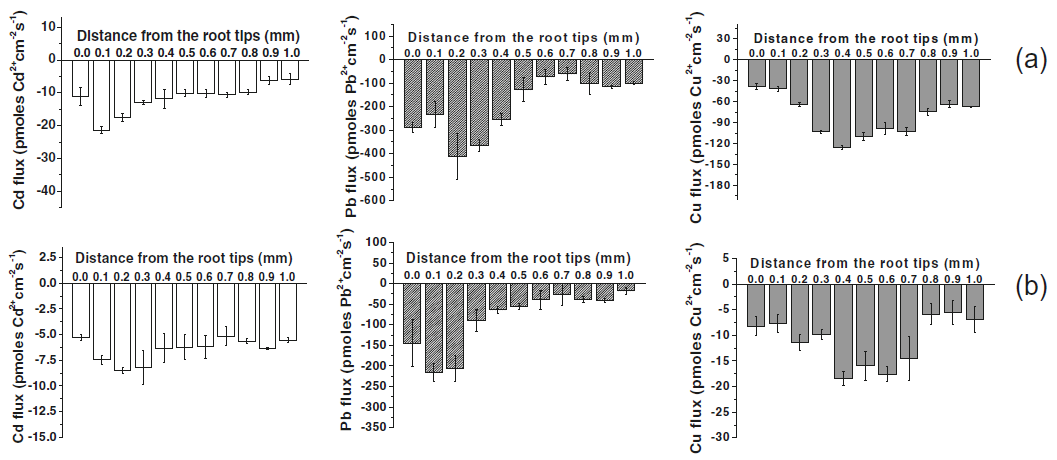NMT是基因功能的活体检测技术,已被31位诺贝尔奖得主所在单位,及北大、清华、中科院使用。
NMT历史上的今天
2016年11月13日,中科院烟台海岸带研究所骆永明、李连祯利用NMT在Plant and Soil 上发表了标题为Determining the fluxes of ions (Pb2+, Cu2+ and Cd2+) at the root surface of wetland plants using the scanning ion-selective electrode technique的研究成果。
期刊:Plant and Soil
主题:使用扫描离子选择电极技术确定湿地植物根表面离子(Pb2+,Cu2+和Cd2+)的通量
标题:Determining the fluxes of ions (Pb2+, Cu2+ and Cd2+) at the root surface of wetland plants using the scanning ion-selective electrode technique
影响因子:3.410
检测指标:Pb2+、Cu2+、Cd2+流速
作者:中科院烟台海岸带研究所骆永明、李连祯
英文摘要
Measuring specific ion fluxes from different regions of the root under practical physiological conditions is crucial for understanding metal uptake mechanisms by plants.
We developed and tested a neutral carrier-based liquid-membrane Pb2+ and Cu2+ ion selective microelectrode (ISME) to investigate ion-transport processes along the roots of three common wetland plant species.
The Pb2+ and Cu2+ ISME exhibited a Nernstian response with Pb2+ and Cu2+ activities as low as 1.0 nM and 1.0 μM in deionized water and simulated soil solution, respectively. Phragmites australis had a region of Cu2+ release for approximately the first 200 μm, while it exhibited Pb2+ and Cd2+ outward net flux up to the first 500 μm. Although in older sections of the root of Phragmites australis there were areas of influx of Cu2+, Pb2+ and Cd2+, the overall influx was much smaller than that of Typha latifolia or Canna indica. Such a reduced uptake and/or an increased efflux of metal ions across the root-cell plasma-membrane might explain the higher resistance of Phragmites australis to metals, at least in part.
The Pb2+ and Cu2+ ISMEs are shown to permit detailed investigation of heavy-metal ion transport in plant roots, especially for plants used for phytoremediation.
中文摘要(谷歌机翻)
在实际的生理条件下,测量来自根不同区域的比离子通量对于理解植物对金属的吸收机理至关重要。
我们开发并测试了基于中性载体的液膜Pb2+和Cu2+离子选择性微电极(ISME),以研究沿三种常见湿地植物物种根部的离子迁移过程。
在去离子水和模拟土壤溶液中,Pb2+和Cu2+的ISME表现出Nernstian响应,Pb2+和Cu2+的活性分别低至1.0 nM和1.0μM。芦苇在大约最初的200μm处具有Cu2+释放区域,而在最初的500μm处表现出Pb2+和Cd2+向外净通量。尽管在芦苇根部的较老部分中有Cu2+,Pb2+和Cd2+的流入区域,但总流入量比香蒲或印度香豆小得多。穿过根细胞质膜的这种减少的金属离子吸收和/或增加的金属离子外流可能至少部分解释了芦苇对金属的更高抗性。
研究表明,Pb2+和Cu2+ ISME可以详细研究植物根特别是用于植物修复的植物中重金属离子的转运。

Fig. 3 Measurement of fluxes (outward positive) of Cd2+,Pb2+ and Cu2+ (mean ± standard error) across the root tips of three common wetland plant species, Typha latifolia (a) Canna indic (b) and Phragmites australis (c), using Cd2+,Pb2+ and Cu2+ ion selective microelectrodes and the scanning ion-selective electrode higher metal influx in the root regions, especially in the meristematic and elongation zone (Fig. 3).
文章链接:
http://link.springer.com/10.1007/s11104-016-3109-5
